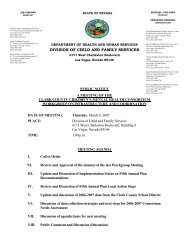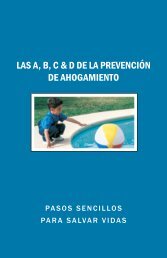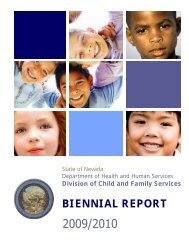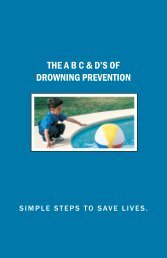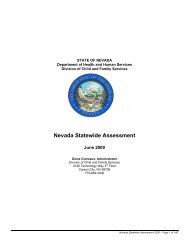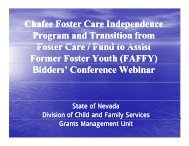STATE OF NEVADA - Division of Child and Family Services
STATE OF NEVADA - Division of Child and Family Services
STATE OF NEVADA - Division of Child and Family Services
Create successful ePaper yourself
Turn your PDF publications into a flip-book with our unique Google optimized e-Paper software.
programs: $244,633 was allocated to <strong>Family</strong> Resource Centers (FRC’s) to provide baseline support for FRC’s statewide;<br />
$100,000 was allocated to the Institute <strong>of</strong> Applied Research <strong>of</strong> St. Louis, MO, to provide an evaluation <strong>of</strong> the Differential<br />
Response (DR) program; $50,000 was allocated to the <strong>Division</strong> <strong>of</strong> <strong>Child</strong> <strong>and</strong> <strong>Family</strong> <strong>Services</strong> to support the Domestic<br />
Violence program <strong>of</strong> the Nevada Outreach Training Organization in Pahrump, NV; <strong>and</strong> $26,815 was allocated to Positively<br />
Kids to provide respite care for families with medically fragile children. Each grantee is required to submit a Quarterly<br />
Report with information about their program’s progress on their goals <strong>and</strong> objectives, the number <strong>of</strong> unduplicated<br />
participants in their programs, <strong>and</strong> results <strong>of</strong> “client satisfaction” surveys. In addition, two organizations were awarded<br />
funds for statewide programs. These included the Area Health Education Centers <strong>of</strong> Southern Nevada, which is the<br />
Nevada Chapter <strong>of</strong> Prevent <strong>Child</strong> Abuse America <strong>and</strong> the Washoe County District Health <strong>Division</strong> which coordinated a<br />
statewide media campaign for child abuse awareness <strong>and</strong> prevention.<br />
Grants require a collaborative efforts <strong>and</strong> leveraging <strong>of</strong> funds. All <strong>of</strong> the grantees that received CTF grants used the funds<br />
to enhance <strong>and</strong>/or exp<strong>and</strong> existing programs. Seven <strong>of</strong> the organizations used CTF monies for specific programs they<br />
would otherwise not have been able to provide. The 12 CTF grants awarded through the competitive process expended<br />
96% <strong>of</strong> the funds awarded for in SFY 2009. Final expenditures for SFY 2010 will not be available until July 2010. Most <strong>of</strong><br />
the grantees met or exceeded their stated goals <strong>and</strong> objectives.<br />
In SFY 2010 grantees who received funds to provide parenting programs were required to use the Protective Factors<br />
Survey (PFS) for pre/post assessments. The PFS was developed by FRIENDS National Resource Center in collaboration<br />
with the University <strong>of</strong> Kansas Institute for Educational Research <strong>and</strong> Public Service. The PFS is a st<strong>and</strong>ardized tool that<br />
contains 20 statements. Respondents rate how <strong>of</strong>ten each statement is true. The PFS indicates areas <strong>of</strong> improvement in<br />
family function, nurturing <strong>and</strong> attachment, emotional support, <strong>and</strong> concrete support. Each <strong>of</strong> the protective areas have<br />
been researched <strong>and</strong> determined to be valid measures <strong>of</strong> child protection <strong>and</strong> family well-being. PFS has an<br />
accompanying database that allows grantees to house their own data <strong>and</strong> easily transfer quarterly data information to the<br />
GMU. The use <strong>of</strong> the PFS will allow the grant administrators to get the same information from all the grantees who are<br />
presenting parenting programs.<br />
Because <strong>of</strong> a CBCAP grant requirement for grantees to be part <strong>of</strong> a statewide network, all CTF funded programs are<br />
required to participate in Prevent <strong>Child</strong> Abuse Nevada meetings, which are videoconferenced four times a year. In SFY09<br />
many <strong>of</strong> the CTF grantees participated in the planning <strong>and</strong> implementation <strong>of</strong> the “Pinwheels for Prevention” campaign in<br />
April. A goal for SFY10 was to have all the grantees take an active role in their communities. To accomplish this goal, the<br />
grant managers continued work with grantees to ensure the goals <strong>and</strong> objectives were measurable <strong>and</strong> the reporting<br />
accurately reflects the funded program.<br />
Differential Response: This program has been in operation since February 2007. Differential Response began in two<br />
service zones in Clark County <strong>and</strong> has now been implemented in areas <strong>of</strong> the state where over 98 percent <strong>of</strong> residents<br />
live. The percent <strong>of</strong> maltreatment reports referred for a DR family assessment response is low but rising—about 9% for<br />
reports received in 2009. The Nevada DR model, which involves <strong>Family</strong> Resource Centers (FRC) in all DR family<br />
assessment cases from start to finish, is unique among states that have implemented DR. Ten <strong>Family</strong> Resource Centers<br />
<strong>and</strong> the <strong>Child</strong>ren’s Cabinet in Washoe County provide DR services in 11 Nevada counties. Table 40 shows the total<br />
number <strong>of</strong> DR locations statewide, as well as the total number <strong>of</strong> staff employed in these programs. In the few months <strong>of</strong><br />
operation in SFY 2007 there were two programs in Clark County with four staff. This has grown each year until 2009 <strong>and</strong><br />
is now stable. There are currently 12 DR programs statewide with 23 community based staff.<br />
Table 40: Nevada Differential Response (DR) Program Report<br />
Number <strong>of</strong> DR programs<br />
SFY 07<br />
2/28/07 –<br />
6/30/07<br />
2<br />
(Las Vegas)<br />
SFY 08 SFY 09 SFY 10<br />
Current Status<br />
7<br />
(4 Las Vegas, 2<br />
Washoe, 1 Elko)<br />
12<br />
(5 Las Vegas, 2<br />
Washoe, 5 Rural)<br />
12<br />
(5 Las Vegas, 2<br />
Washoe, 5 Rural)<br />
Number <strong>of</strong> Community Based DR Staff 4 16 23 23<br />
Source: Nevada Differential Response Report 02/28/07 through 02/28/10<br />
As <strong>of</strong> February 28, 2010, there were 251 open DR cases statewide. From SFY 2007 to SFY 2010 at the same time there<br />
has been a 670% increase in the number <strong>of</strong> families referred to DR from CPS. Over the past three years, a total <strong>of</strong> 2,057<br />
cases have been referred. 13.9% <strong>of</strong> these cases have been returned to CPS, <strong>and</strong> 73.4% <strong>of</strong> cases have been closed.<br />
Cases have been returned to CPS for the following reasons: 1) Unable to locate family or family has moved; 2) <strong>Family</strong><br />
Nevada APSR – SFY 2010<br />
Page 75 <strong>of</strong> 108



